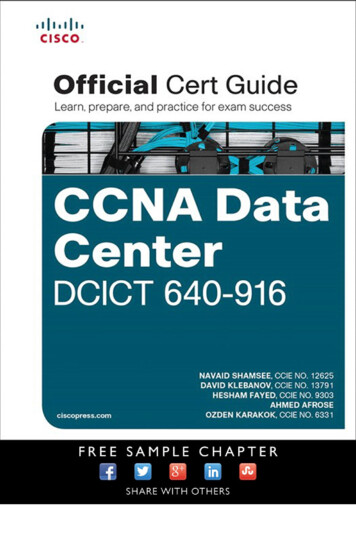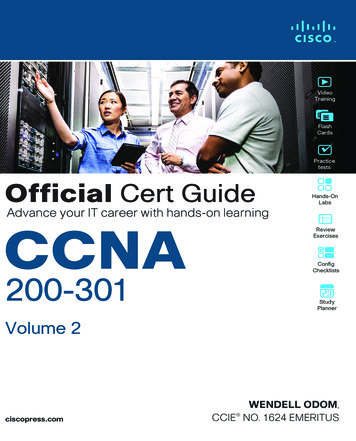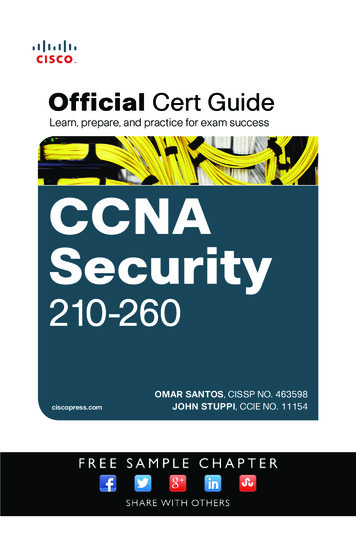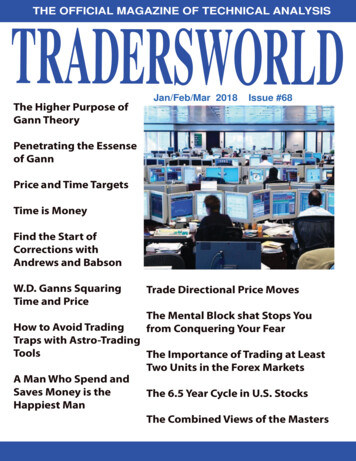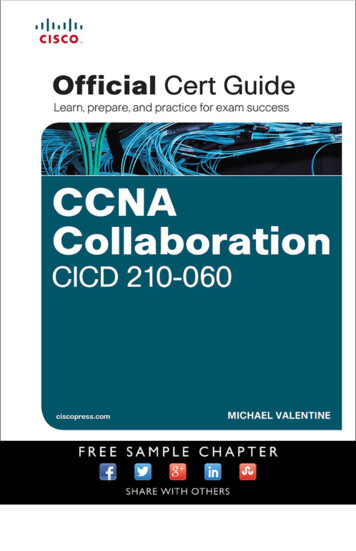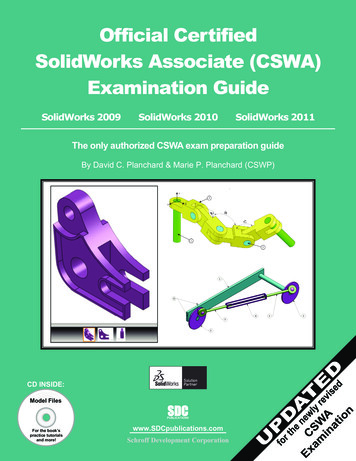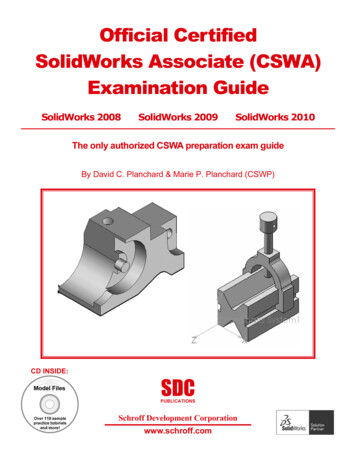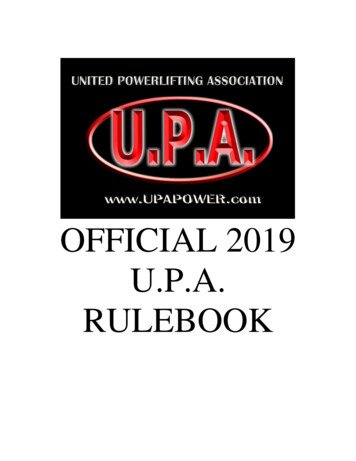
Transcription
OFFICIAL 2019U.P.A.RULEBOOK
ContentsGeneral Rules3Bodyweight and Age Categories4Equipment and Specifications5-9Powerlifts and rules of Performance10-13Weighing In13Order or competition14-17Referees17-21National Records21Raw Division Equipment22 - 23UPA Memberships24UPA-AD Division (Drug Tested)252
General Rules1. The United Powerlifting Association recognizes the following lifts,which must be performed in the designated sequence in allapplications conducted under U.P.A rules, with the exception of singlelift competitions:a. squat2.3.4.5.6.7.b. benchc. deadlift totalThe highest total of the best successes of each lift will result in aTotal. Winner of the competition will be determined by the highesttotal.4th attempts in any given lift can be taken for All-time worlds recordsbut will not count on the lifters total. To be eligible for a 4th attempt asuccessful third attempt must be within 20kg of the current worldrecord.In the event that 2 or more lifters are attempting to break the sameWorld Record the lighter lifter will go first. If that attempt issuccessful the next lifter can take the next available attempt to breakthe record just set. If the first lifter fails to make his attempt the nextlifter may take the unsuccessful weight of the first lifter. Thuseliminating what is known as the “anticipation rule”.All competitions where “Best Lifter Awards” are presented. “BestLifter Awards” will be established by Meet Directors choice -WilksFormula or Schwartz/Malone Formula.For all U.P.A sanctioned events, lifters must have a current federationmembership card secured prior to the event, as well as present card atweigh in.24 Weigh In rule will be in effect for ALL U.P.A. sanctioned events.Weigh ins cannot be opened until 24 hours prior to the advertised startof the first flight. Weigh in times in that 24 hour period will be at themeet director’s discretion.Chalk is the only substance allowed on a lifter. No stick-um isallowed on the lifter. Meet Directors discretion for stick-um allowedon the lifters feet.3
Bodyweight CategoriesMENWOMEN52.0kg Class up to 52.0kg56.0kg Class from 52.01 to 56.0kg60.0kg Class from 56.01 to 60.0kg67.5kg Class from 60.01 to 67.5kg75.0kg Class from 67.01 to 75.0kg82.5kg Class from 75.01 to 82.5kg90.0kg Class from 82.51 to 90.0kg100.0kg Class from 90.01 to 100.0kg110.0kg Class from 100.01 to 110.0kg125.0kg Class from 110.01 to 125.0kg140.0kg Class from 125.01 to 140.0kg140.0 kg Class from 140.01 to unlimited44.0kg Class up to 44.0kg48.0kg Class from 44.01 to 48.0kg52.0kg Class from 48.01 to 52.0kg56.0kg Class from 52.01 to 56.0kg60.0kg Class from 56.01 to 60.0kg67.5kg Class from 60.01 to 67.5kg75.0kg Class from 67.51 to 75.0kg82.5kg Class from 75.01 to 82.5kg90.0kg Class from 82.51 to 90.0kg90.0 kg Class from 90.01 to unlimitedAge CategoriesMen and Women - Open (Senior): from 13 years upward.Master i)ii)iii)iv)v)vi)vii)viii)ix)from 40 years to and including 44 years of agefrom 45 years to and including 49 years of agefrom 50 years to and including 54 years of agefrom 55 years to and including 59 years of agefrom 60 years to and including 64 years of agefrom 65 years to and including 69 years of agefrom 70 years to and including 74 years of agefrom 75 years to and including 79 years of agefrom 80 years upwardSub Masterfrom 33 years to and including 39 years of ageJuniorfrom 20 years to and including 23 years of ageTeenagefrom 13 years to and including 15 years of agefrom 16 years to and including 17 years of agefrom 18 years to and including 19 years of ageCompetitive lifting shall be restricted to competitors aged 13 years and over. Thelifter must have attained minimum age on day of the competition where age limitsare imposed. A lifter must lift in the age group in which he or she is currently in, until they reach thestated upper limit of that category.4
Equipment and Specifications1. PlatformAll lifts shall be carried out on a platform not less than 2.46m x 2.46m (8ft x 8ft) andsecure enough to insure the safety of the lifter, spotters, and loaders. The surface ofthe platform must be firm, nonslip, and level with no discernible seams in the vicinityof the general lifting area. Rubber mats or similar sheeting materials are permitted.No one is allowed on the platform during lifting sessions except the lifter, thedesignated spotters, the three referees on duty, and other meet officials as designatedif the need arises. Any cleaning, mopping, brushing, or adjusting of the platform,or equipment will be handled solely by these personnel.2. Bars and DiscsFor all powerlifting competitions under the rules of the U.P.A., only disc barbells arepermitted. Only bars and discs that meet all specifications may be used throughoutthe entire competition and for all lifts. The use of bars or discs that do not conformto specifications will invalidate any records that may have been accomplished.Different bars suited to particular lifts may be utilized providing that they conform tothe specifications.Specifications are as follows:a.The bar shall be straight, well knurled, and grooved and shall conformto the following dimensions:i)ii)iii)iv)v)vi)vii)b.Total overall length not to exceed 2.2m, except for specialized squat bar.Distance between the inside collar is not to exceed 1.32m or be less than1.31m except for specialized squat bar.Diameter of the bar is not to exceed 29mm or be less than 1.31m, except forspecialized squat bar.Weight of the bar and collars is to be 25kg.of the sleeve 49.5 - 52mm.There shall be a circumferential machine marking or the bar shall be taped soas to measure 81cm between machining or tape.Specialized squat bar shall have a maximum diameter of 32mm; a maximumsleeve length of 508mm; distance between inside collar faces not to exceed1434mm; a maximum overall length of 2400mm. Weight 30kg include collarsand shall be voted on by competitors.Specialized bar shall be used for deadlifting to include the Oki deadlift bar, or theElite deadlift bar.Discs shall conform as follows:i)ii)iii)iv)v)All discs used in competition must weigh within .25% of their correct face value.The hole size in the middle of the disc shall be such that the disc fits on thebar without excessive play.Discs must be of the following range 1.25kg, 2.5kg, 5kg, 10kg, 15kg, 20kg,45kg and 50kg, OR at the meet directors discretion pound plates can be used.For record purposes, even lighter discs may be used to achieve a weight of atleast 500 grams more than the existing record.All discs must be clearly marked with their weight and loaded in the sequence5
vi)vii)viii)of heavier discs innermost with the small discs in descending weight.The first and heaviest discs loaded on the bar must be loaded face in; with therest of the discs loaded face out as weight is loaded.The diameter of the largest disc shall be no more than 45cm.It is suggested that discs conform to the following color coding: 10kg andbelow - any color; 15kg - yellow; 20kg - blue; 25kg - red; 45kg - gold; 50kg- green.Preferred bar for the U.P.A include Texas Squat Bar, Texas Power Bar, Oki Squat Bar, OkiDeadlift Bar, Elite Deadlift Bar, all Ivanko Bars.c. Collarsi)ii)Shall always be used in competition.Must weigh 2.5kg each unless specialized squat bar is used. Collars madespecifically for specialized squat bar are to be used with that specific bar.d. Misc.Should blood appear on the bar, or open wounds on lifter, it must be rectified immediately.3.Squat RacksIn all U.P.A. sanctioned event a monolift type squat apparatus shall be used. As well, an identicalapparatus. Squat ER Racks can be used in all Raw Meets.Shall be available in the warm up area.4. BenchThe bench shall be of sturdy construction for maximum stability and conform to thefollowing dimensions:a) Length - not less than 1.22mm and shall be flat and level.b) Width - 29-32cmc) Height - 42-45cm measured from the floor to the top of the padded surfaceof the bench without being depressed or compacted.d) The height of the uprights on adjustable benches should be from a minimumof 82cm to a maximum of 100cm measured from the floor to the bar restposition. On nonadjustable benches the height of the uprights must bebetween 87cm and 100cm from the floor to the bar rest position.e) The minimum width between the insides of the bar rests shall be 1.10m.5. LightsA system of lights shall be provided whereby the referees make known theirdecisions. Each referee will control a white and a red light, representing a “good lift”or “no lift” respectively. The lights must be wired in such a way that they light up together and notseparately when activated by the three referees. It is preferable thatthe lights be arranged horizontally corresponding with the positions of the threereferees.6
Costume and Personal Equipment1.Lifting SuitA lifting suit of the basic design shall be worn. It must be an individual full length article of clothfabric. Its construction may consist of multiple plies to any thickness of material, but must as awhole, be a singular component. The straps must be worn over the shoulders at all times whilelifting in competition. It may be of any color or colors. The length of the leg, when worn, mustnot extend beyond mid-thigh (medial point between crotch and top of knee cap).2.T-ShirtsOne shirt (otherwise known as a T-shirt) with or without sleeves, may be worn under the liftingsuit. It must be an individual article of cloth fabric. Its construction may consist of multiple pliesbut must, as a whole, be a singular component. The thickness shall not be designed to increase,enlarge, or enhance the bodies natural musculature. Sleeves must be short and remain above theelbow when worn. It may be any color or colors, but shall not portray indecency or be offensiveto the spirit of the competition.3.BriefsA brief of any design may be worn, provided that the length of the legs does not exceed mid thigh,and that the waist does not exceed approximately mid torso. The construction may consist ofmultiple plies of material, but must, as a whole, be a singular component.4.SocksUp to two pair of socks may be worn. When worn they may not extend over the knee nor on theleg so that they touch any knee wrapping or knee cap supporter.5.Special ConsiderationsWomen may wear addition protective briefs or panties. Women may also wear a bra, provided itcontains no special support. Plastic or fabric shin guards may be worn but must not extend to apoint higher than the lower border of the patella and not lower than the superior border of theankle joint.6.BeltA competitor may wear a belt. If worn, it shall be on the outside of the lifting suit. The belt maynot exceed 4 inches at its widest point. The belts thickness may not exceed 13 mm.8.FootwearFootwear more substantial than basic socks must be worn. The only restrictions to such footwearis that no metal cleats or spikes are permitted. Deadlift slippers are OK for the deadlift.9.WrapsThe fabric nature shall be an elastic weave primarily of polyester, cotton, or medical crepe singlyor in combination.7
Wraps may be used as follows:Wrists – Wraps not exceeding 1.5 m in length and 8cm in width may be worn. Wrapscan have a thumb loop not to be attached during lifting. Velcro closure wraps arepermitted.b) Knees – Wraps not exceeding 3 m in length may be worn. Knee wraps are not permittedto touch any part of the lifters lifting attire (ie – squat suit, briefs, spandex type shorts orunderwear, etc), nor the top of a sock.c) Elbows – Elbow sleeves may be worn during the squat and the deadlift competition butnot during the bench press. They may cover the general elbow area but not extend to thewrist or the shoulder.a)10. Bench ShirtsA bench shirt may be worn with multiple plies of material. The shirt must, as a whole, be of asingular component. The material may be denim, canvas, or polyester. The shirt can be of an openback or closed back nature. The shirt sleeves must not exceed the top of the elbow. The neck ofthe shirt must remain at all times covering the armpit. The shirt must be worn underneath thelifting suit, with the belt on the outside of the lifting suit.11. PlastersBand-Aids or tape may be worn only in the event that it is keeping a wound closed. This will needto have clarification from the lead judge. In no way may anything be worn to help aid the lifter ingripping the bar with the exception of chalk.Preferred gear manufacturers include: Titan, Overkill, Metal, Crains, and Frantzequipment and Inzer Advanced Designs.8
Inspection of Personal Equipment1. At all competitions there will be no official inspection of costume and personalequipment prior to lifting.2. It will be the lifters responsibility to be present on the platform outfitted inaccordance with the rules governing costume and personal equipment.3. Any items mentioned previously under personal equipment may beinspected prior to the competition if the lifter has any doubt as to the legality of thatitem. Such inspections should be requested during the weigh-in sessions and directedto one of the U.P.A. referees present,. Such inspections may also be made at any time priorto lifting or upon leaving the platform by one of the appointed U.P.A judges.4. Items of personal attire not covered in the rules governing costumes and personalequipment such as: Headbands, mouthpieces, watches, eyewear, and feminine hygienearticles are permitted. Hats are also permitted on the platform providing that they are not of anoffensive nature.5.Any items worn on the platform considered objectionable by virtue of being unclean, torn ortattered, indecent, or offensive to the spirit of the competition shall be rejected before the lifter ispermitted to proceed.6.If a lifter performs on the platform wearing or using any item that is illegal or notverifiably approved, the lifter shall lose credit for that lift, and may be disqualifiedfrom the competition. Any minor oversights, or items covered in (5) above, noticedbefore the lifter performs, should be indicated to the lifter and rectified prior tocontinuing.7.Any lifter performing on the platform may be inspected before or after a lift if any of the refereesdoubt the legality of the costume or personal equipment being used.8.Any lifter successful in a world record attempt must be inspected. Inspection may be solely visualwhen the legality of the lifter’s costume and personal equipment isobvious, or otherwise more thorough. Thorough inspections should be performedoff the platform, preferably in a private area, either by the three referees, or officialsdelegated by the referees in cases where the lifter is of the opposite sex. In all casesan announcement shall be made by the head referee to the speaker and recordsprocessor that the record has been verified.9
Powerlifts and Rules of PerformanceSquat1.After removing the bar from the squat apparatus (Monolift) while facing the front of the platform, thelifter may move forward or backward to establish the lifting position. The top of thebar not more than 3cm below the top of the anterior deltoids. The bar shall be heldhorizontally across the shoulders with the hands and/or fingers gripping the bar, andthe feet flat upon the platform with the knees locked.2.The lifter shall start the squat when he/she feels ready. The lifter DOES NOT have to wait for the squatCommand.3.The lifter must bend the knees and lower the body until the top surface of the legs at the hip joint are lowerthan the top of knees. (See Diagrams 1, 2, 3 and 4).4.The lifter must recover at will, without double bouncing, to an upright position withthe knees locked. The bar may stop, but there must be no downward motion duringrecovery. As soon as the lifter demonstrates a controlled final position, the headreferee will give the signal indicating completion of the lift and to replace the bar.5.The signal to replace the bar will consist of a backward motion of the arm and theaudible command “Rack”. The lifter must then make a bona fide attempt to returnthe bar to the racks.6.The lifter shall face the front of the platform, towards the head referee.7.The lifter shall not hold the collars or discs at any time during the performance of thelift. However, the edge of the hands gripping the bar may be in contact with theinner surface of the collar.8.Not more than five and not less than two loaders/spotters shall be on the platform atany time.9.The lifter may enlist the help of spotters in removing the bar from the racks;however, once the bar has cleared the racks, the spotters shall not physically assisthe lifter with regards to actually getting into the proper set position. The spottersmay assist the lifter to maintain control should the lifter stumble or demonstrate anyevident instability.Lifters can’t have their own back spotter (Coach/Handler/Teammate). Meet directors must use their owndesignated back spotter. Lifters coaches or handlers can help spot on the sides with the meet directorsdesignated spotters.10
10.The lifter may be given an additional attempt at the same weight at the head referee’s discretion if failure inan attempt was due to any error by one or more of the spotters or loaders.Causes for Disqualification of a Squat1.2.3.4.5.6.7.8.9.10.Failure to observe the head referee’s signals at the completion of a lift.Double bouncing or more than one recovery attempt at the bottom of the lift.Failure to assume an upright position with knees locked at the commencement or completion of the lift.Movement of the feet laterally, backward or forward that would constitute a step orstumble.Failure to bend the knees and lower the body until the surface of the legs at the hipjoint is lower than the tops of the knees. (Refer to Diagrams 2, 3 & 4).Any resetting of the feet after the initial downward movement by the lifter.Contact with the bar by the spotters between the referee’s signals.Contact of elbows or upper arms with the legs.Failure to make a bona fide attempt to return the bar to the racks.Any intentional dropping or dumping of the bar.Bench Press1.The front of the bench must be placed on the platform facing the spectators.2.The lifter must lie backward with shoulders and buttocks in contact with the flatbench surface. The elected position of the buttocks shall be maintained throughoutthe attempt. The lifter’s shoes or toes must be in solid contact with the platform orsurface. The position of the head is optional.3.To achieve firm footing, a lifter of any height may use discs or blocks to build up the surface of the platform.Whichever method is chosen, the shoes must be in a solid contact with the surface. If blocks are used, theyshall not exceed 45cm x 45cm.4.Not more than five and not less than two loaders/spotters shall be in attendance.The lifter may enlist the help of one or more of the designated spotters or enlista personal spotter or spotters in removing the bar from the racks. Only designated spotters mayremain on the platform during the lift, unless a 3-man head off is used. If a 3 man lift off is used. The 3spotters designated by the lifter must spot the entire lift. This is for the safety of the lifter. We don’t want thebar falling on the lifter’s body or head while lifter’s designated spotters are replacing the meets designatedspotters. The lift off must be to arm’s length and not down to the chest. A designated spotter, having provideda center lift off, must immediately clear the area in front of the head referee and move to either side of thebar. If the personal middle spotter does not immediately leave the platform area and/or inany way distracts or impedes the head referees’ responsibilities, the referees maydetermine that the lift is unacceptable, and be declared “no lift” by the referees andgiven three red lights.5.The spacing of the hands shall not exceed 81cm, measured between the forefingers. The bar shall havecircumferential machine markings or tape indicating this maximum grip allowance. If the lifter should use anoffset or unequal gri
UPA Memberships 24 UPA-AD Division (Drug Tested) 25 . 3 General Rules 1. The United Powerlifting Association recognizes the following lifts, which must be performed in the designated sequence in all applications conducted under U.P.A rules, with the exception of single lift competitions: .File Size: 342KB



